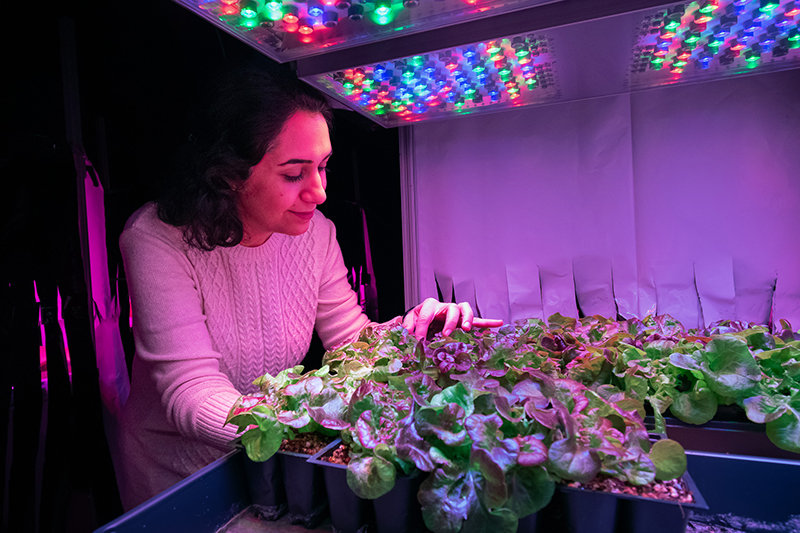At Purdue University (Indiana, USA) researchers in the Department of Horticulture and Landscape Architecture have designed two simple LED lighting strategies to increase yield and reduce energy costs for the vertical farming sector of indoor agriculture.
The ‘close-canopy’ and ‘focused-lighting’ strategies developed by PhD candidate Fatemeh Sheibani and Professor Cary Mitchell, capitalise on LED lighting’s special properties. “Right now energy for lighting amounts to about 30% of total operational costs” says Professor Mitchell. Through their efforts the pair hope to decrease the production costs associated with lighting used in vertical farming.
The work of Sheibani and Mitchell is part of a project called OptimIA (Optimising Indoor Agriculture). The project, led by Michigan State University, includes collaborators at Purdue, University of Arizona and Ohio State University. OptimIA is sponsored by the U.S. Department of Agriculture’s Specialty Crop Research Initiative.
Reduced separation distances with close-canopy lighting
Close-canopy lighting works because like the sun, LEDs shine in all directions. At standard plant/light separation distances, significant light streaming at wide angles over the plants misses them entirely. But with reduced separation distances, the plants absorb light that would otherwise go to waste.
LEDs are the lighting system of choice for indoor farming because of their relative energy efficiency and long lifetimes, Sheibani says. But improved LEDs also have high photon efficacy, meaning that electric energy is more readily converted to light that plants can use efficiently.
Still, inefficient capture of LED light reduces their benefits. Many indoor farmers, for instance, mistakenly believe that they can place their LEDs anywhere. But Sheibani and Mitchell noticed both in vertical farms and in smaller-scale experiments that the light fell not only on the plants but also on the walls and walkways.
By reducing the distance between the LED system and the leaf canopy, the researchers were able to reduce such wasted light.
“We can improve canopy photon capture efficiency, as we call it, as long as we use LEDs correctly,” Sheibani said. “Canopy photon capture efficiency is the fraction of photons that reach the photosynthesising machinery of the plants.”

Both of Purdue’s tested scenarios found that the closest separation distance had the highest energy utilisation efficiency.
Optimising light focus (direction) based on seedling growth and size
Sheibani and Mitchell also are testing an energy-saving, focused-lighting approach that relies on a custom-made LED system with selective controls. They are examining how small, individual, widely separated plants such as seedlings fare under slowly spreading beams of light rather than full coverage all the time.
“When seedlings emerge after germination, the very small plants are wide apart,” Mitchell said. “It takes two weeks for them to grow together and close a canopy of baby greens. Everything in between is mostly wasted light until then.”
Sheibani and Mitchell’s system minimises that waste. When plants are still small, they use full-coverage LED lighting inefficiently, Sheibani said. But it is possible to save energy in the earlier growth stages with focused lighting.
“There’s a lot of excitement about indoor ag and people are jumping into it.” concludes Mitchell “But they don’t really have the secret for long-term profitability yet. That’s where academic research such as the OptimIA project comes in to help.”


